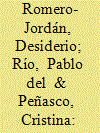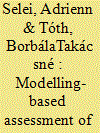|
|
|
Sort Order |
|
|
|
Items / Page
|
|
|
|
|
|
|
| Srl | Item |
| 1 |
ID:
150382


|
|
|
|
|
| Summary/Abstract |
The deep economic crisis and the sharp rise in electricity prices have reduced electricity demand by Spanish households. This paper aims to analyse the responsiveness of household electricity demand and the welfare effects related to both factors in the 2006–2012 period by applying a demand model estimated with the quantile regression method. The results show that the electricity consumption of medium-high income households is particularly responsive to price increases, whereas that of medium-low income households is more responsive to changes in income. The retail electricity price increases and the economic crisis have led to lower and steeper U-shape price elasticities of demand and higher and steeper N-shape income elasticities of demand. The joint impact of those two factors on the welfare of lower-income households is higher in relative terms (i.e., as a share of household income) than for other income groups. These results suggest that the economic crisis and increases in retail electricity prices have had detrimental welfare effects, especially on the lower-income segment of the population. They should be considered when financing climate and energy policies through the electricity bill and provide a rationale to take such support, which pushes the retail electricity price upwards, out of the electricity bill.
|
|
|
|
|
|
|
|
|
|
|
|
|
|
|
|
| 2 |
ID:
182794


|
|
|
|
|
| Summary/Abstract |
Conventional wisdom suggests that, if a large nation reduces tariffs, the Rest of the World (RoW) as a whole should immediately experience gains from trade. However, little simulation evidence has been provided to evaluate the welfare effects of China's tariff reduction upon its WTO accession on each of its trade partners. This paper addresses the above issue under both the perfectly competitive model and the monopolistic competition framework à la Eaton and Kortum (2002) and Melitz (2003). Armed by the method of Dekle, Eaton, and Kortum (2007, 2008) to quantify the individual countries' responses to the “China (trade liberalization) shock” at equilibrium, we could check the extent to which global welfare benefit from the import tariff reduction after China's entry into the WTO. The quantitative results show that, both China and the RoW benefit from Chinese participation into the WTO, with estimated welfare gains falling in a range of [1.4697%, 3.8743%] and [0.0743%, 0.1015%], respectively. That is to say, about 58.24% of total benefits extracted from China's accession into the WTO worldwide flow to countries other than China under perfect competition; while under monopolistic competition, the whole world enjoys a 0.1571% welfare increases if firms' entry is restricted, of which 42.64% are injected into the RoW, an equivalent amount of 23.3903 billion US dollars. Since allowing for firms' entry and exit would lead to adjustments in both aggregate price indices and government tariff revenues, welfare gains of the world significantly increase (0.2474%), but these adjustments would slightly distort the welfare changes for other countries in the sense that only 36.50%, which is equivalent to 32.1008 billion US dollars, overflow to the RoW. As a result, some countries gain more, while some less.
|
|
|
|
|
|
|
|
|
|
|
|
|
|
|
|
| 3 |
ID:
045645


|
|
|
|
|
| Publication |
New York, Harper and Raw Publishers, 1971.
|
| Description |
xi 337p.
|
|
|
|
|
|
|
|
|
|
|
|
Copies: C:1/I:0,R:0,Q:0
Circulation
| Accession# | Call# | Current Location | Status | Policy | Location |
| 009006 | 339/KOP 009006 | Main | On Shelf | General | |
|
|
|
|
| 4 |
ID:
186417


|
|
|
|
|
| Summary/Abstract |
Between 2013 and 2020 the EU set up a complex institutional system to select and support the implementation of energy infrastructure projects that are of European interest (PCIs). EUR 1.4 billion EU support was awarded to 16 natural gas projects between 2014 and 2019, most of them are still under construction. With the decarbonization agenda emerging, fossil investments have a limited lifetime to recover their investment. To assess the net socio-economic benefits of the gas PCI projects a modelling-based cost benefit analysis was applied. Results revealed that the cross-border projects that were implemented so far have a joint socio-economic benefit/cost ratio (B/C) above 1 even in the most conservative scenario setups. The ones with a final investment decision would need to face a high gas price environment in the future to push the B/C above 1, which is the reality since 2021. The other projects on the full EU list of PCIs are not beneficial as a single group, as they serve similar needs. Some individual non-FID projects are though promising.
|
|
|
|
|
|
|
|
|
|
|
|
|
|
|
|
| 5 |
ID:
191392


|
|
|
|
|
| Summary/Abstract |
Tighter fuel economy standards came into force in the EU in 2020. Such standards reduce the usage cost of cars, encouraging people to drive more, a reaction known as the rebound effect. Whether and how to prevent the rebound is an ongoing policy debate – since the rebound eliminates parts of the expected fuel savings – yet the economic analysis of the rebound welfare implications is very scarce. To fill this gap, first the direct rebound for private vehicles in Switzerland is estimated and is found to be between 30% and 40%. Second, the utility surplus from the extra kilometers is estimated for each household, at 7 cents per kilometer on average. This is half the external costs of driving in Switzerland (15 cents per km). This gap supports a rebound mitigation, for instance through an internalization of external costs with a tax on the distance driven.
|
|
|
|
|
|
|
|
|
|
|
|
|
|
|
|
| 6 |
ID:
175269


|
|
|
|
|
| Summary/Abstract |
The Russian gas transit through Ukraine and the possibility of circumnavigating the historically dominant route poses a serious challenge to European gas markets. With the application of market modelling tools, this paper examines Russian export strategies to Europe using different transit route combinations. Although the cessation of Ukrainian transit would not endanger the security of gas supply in Europe, it would result in higher prices in all scenarios. In scenarios that include Nord Stream 2 and TurkStream 2, Ukrainian transit is non-essential for Russia to maintain its current share of EU gas imports. At the same time, the results show that limiting Ukrainian transit is less profitable for Russia: even if all the planned infrastructure is completed, shutting this route would result in losses of close to 5 billion € per year in Russian gas sales. Since it appears inevitable that Nord Stream 2 and TurkStream 2 will be built, a no transit scenario is a real possibility thereafter. In this case the V4 should lobby for Balkan Stream, with investment costs borne by Gazprom. However, if there are continued deliveries via Ukraine there is no need for Balkan Stream.
|
|
|
|
|
|
|
|
|
|
|
|
|
|
|
|
|
|
|
|
|